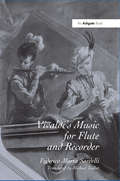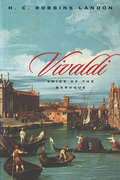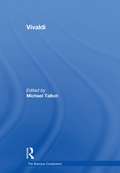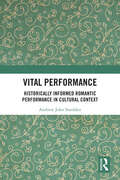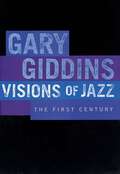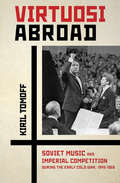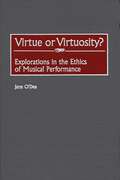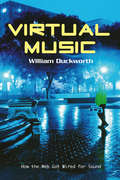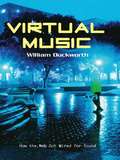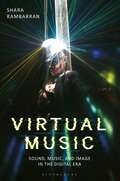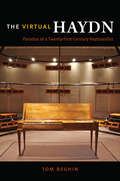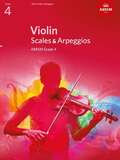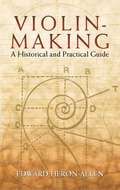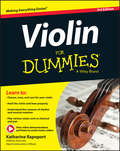- Table View
- List View
Vivaldi's Music for Flute and Recorder
by Michael TalbotFederico Maria Sardelli writes from the perspective of a professional baroque flautist and recorder-player, as well as from that of an experienced and committed scholar, in order to shed light on the bewildering array of sizes and tunings of the recorder and transverse flute families as they relate to Antonio Vivaldi's compositions. Sardelli draws copiously on primary documents to analyse and place in context the capable and surprisingly progressive instrumental technique displayed in Vivaldi's music. The book includes a discussion of the much-disputed chronology of Vivaldi's works, drawing on both internal and external evidence. Each known piece by him in which the flute or the recorder appears is evaluated fully from historical, biographical, technical and aesthetic standpoints. This book is designed to appeal not only to Vivaldi scholars and lovers of the composer's music, but also to players of the two instruments, students of organology and those with an interest in late baroque music in general. Vivaldi is a composer who constantly springs surprises as, even today, new pieces are discovered or old ones reinterpreted. Much has happened since Sardelli's book was first published in Italian, and this new English version takes full account of all these new discoveries and developments. The reader will be left with a much fuller picture of the composer and his times, and the knowledge and insights gained from minutely examining his music for these two wind instruments will be found to have a wider relevance for his work as a whole. Generous music examples and illustrations bring the book's arguments to life.
Vivaldi's Music for Flute and Recorder
by Michael TalbotFederico Maria Sardelli writes from the perspective of a professional baroque flautist and recorder-player, as well as from that of an experienced and committed scholar, in order to shed light on the bewildering array of sizes and tunings of the recorder and transverse flute families as they relate to Antonio Vivaldi's compositions. Sardelli draws copiously on primary documents to analyse and place in context the capable and surprisingly progressive instrumental technique displayed in Vivaldi's music. The book includes a discussion of the much-disputed chronology of Vivaldi's works, drawing on both internal and external evidence. Each known piece by him in which the flute or the recorder appears is evaluated fully from historical, biographical, technical and aesthetic standpoints. This book is designed to appeal not only to Vivaldi scholars and lovers of the composer's music, but also to players of the two instruments, students of organology and those with an interest in late baroque music in general. Vivaldi is a composer who constantly springs surprises as, even today, new pieces are discovered or old ones reinterpreted. Much has happened since Sardelli's book was first published in Italian, and this new English version takes full account of all these new discoveries and developments. The reader will be left with a much fuller picture of the composer and his times, and the knowledge and insights gained from minutely examining his music for these two wind instruments will be found to have a wider relevance for his work as a whole. Generous music examples and illustrations bring the book's arguments to life.
Vivaldi: Voice of the Baroque
by H. C. LandonVivaldi boasted that he could compose a concerto faster than a scribe could copy one. Despite his prolificacy, The Four Seasons, and the majority of his already published work had fallen into obscurity by the time of his death in poverty in 1741. Most of his music-concertos, sonatas, operas, and sacral music-has been published only recently. Very little has been written on Vivaldi for the nonspecialist, especially in English. Landon rediscovers the composer in this accessible and musically informed biography while presenting documentation of the musician's life discovered after the Baroque revival in the 1930s. This book includes illustrations of eighteenth-century Venice and several newly translated letters, thoroughly evoking the style of the time and revealing some of the more personal aspects of Vivaldi's life. "Belongs on the shelf of every serious music student."—Kirkus "Gives a good feel for Vivaldi's life and times . . . and describes particularly well how Vivaldi has been revived."—Booklist "Robbins Landon is marvelously entertaining, extravagantly learned."—The Independent
Vivaldi
by Michael TalbotSince 1978, the 300th anniversary of Vivaldi's death, there has been an explosion of serious writing about his music, life and times. Much of this has taken the form of articles published in academic journals or conference proceedings, some of which are not easy to obtain. The twenty-two articles selected by Michael Talbot for this volume form a representative selection of the best writing on Vivaldi from the last 30 years, featuring such major figures in Vivaldi research as Reinhard Strohm, Paul Everett, Gastone Vio and Federico Maria Sardelli. Aspects covered include biography, Venetian cultural history, manuscript studies, genre studies and musical analysis. The intention is to serve as a 'first port of call' for those wishing to learn more about Vivaldi or to refresh their existing knowledge. An introduction by Michael Talbot reviews the state of Vivaldi scholarship past and present and comments on the significance of the articles.
Vivaldi
by Michael TalbotSince 1978, the 300th anniversary of Vivaldi's death, there has been an explosion of serious writing about his music, life and times. Much of this has taken the form of articles published in academic journals or conference proceedings, some of which are not easy to obtain. The twenty-two articles selected by Michael Talbot for this volume form a representative selection of the best writing on Vivaldi from the last 30 years, featuring such major figures in Vivaldi research as Reinhard Strohm, Paul Everett, Gastone Vio and Federico Maria Sardelli. Aspects covered include biography, Venetian cultural history, manuscript studies, genre studies and musical analysis. The intention is to serve as a 'first port of call' for those wishing to learn more about Vivaldi or to refresh their existing knowledge. An introduction by Michael Talbot reviews the state of Vivaldi scholarship past and present and comments on the significance of the articles.
Vital Performance: Historically Informed Romantic Performance in Cultural Context
by Andrew SneddenHistorically Informed Performance, or HIP, has become an influential and exciting development for scholars, musicians, and audiences alike. Yet it has not been unchallenged, with debate over the desirability of its central goals and the accuracy of its results. The author suggests ways out of this impasse in Romantic performance style. In this wide-ranging study, pianist and scholar Andrew John Snedden takes a step back, examining the strengths and limitations of HIP. He proposes that many problems are avoided when performance styles are understood as expressions of their cultural era rather than as simply composer intention, explaining not merely how we play, but why we play the way we do, and why the nineteenth century Romantics played very differently. Snedden examines the principal evidence we have for Romantic performance style, especially in translation of score indications and analysis of early recordings, finally focusing on the performance styles of Liszt and Chopin. He concludes with a call for the reanimation of culturally appropriate performance styles in Romantic repertoire. This study will be of great interest to scholars, performers, and students, to anyone wondering about how our performances reflect our culture, and about how the Romantics played their own culturally-embedded music.
Vital Performance: Historically Informed Romantic Performance in Cultural Context
by Andrew SneddenHistorically Informed Performance, or HIP, has become an influential and exciting development for scholars, musicians, and audiences alike. Yet it has not been unchallenged, with debate over the desirability of its central goals and the accuracy of its results. The author suggests ways out of this impasse in Romantic performance style. In this wide-ranging study, pianist and scholar Andrew John Snedden takes a step back, examining the strengths and limitations of HIP. He proposes that many problems are avoided when performance styles are understood as expressions of their cultural era rather than as simply composer intention, explaining not merely how we play, but why we play the way we do, and why the nineteenth century Romantics played very differently. Snedden examines the principal evidence we have for Romantic performance style, especially in translation of score indications and analysis of early recordings, finally focusing on the performance styles of Liszt and Chopin. He concludes with a call for the reanimation of culturally appropriate performance styles in Romantic repertoire. This study will be of great interest to scholars, performers, and students, to anyone wondering about how our performances reflect our culture, and about how the Romantics played their own culturally-embedded music.
Visions of Jazz: The First Century
by Gary GiddinsPoised to become a classic of jazz literature, Visions of Jazz: The First Century offers seventy-nine chapters illuminating the lives of virtually all the major figures in jazz history. From Louis Armstrong's renegade-style trumpet playing to Sarah Vaughan's operatic crooning, and from the swinging elegance of Duke Ellington to the pioneering experiments of Ornette Coleman, jazz critic Gary Giddins continually astonishes the reader with his unparalleled insight. Writing with the grace and wit that have endeared his prose to Village Voice readers for decades, Giddins also widens the scope of jazz to include such crucial American musicians as Irving Berlin, Rosemary Clooney, and Frank Sinatra, all primarily pop performers who are often dismissed by fans and critics as mere derivatives of the true jazz idiom. And he devotes an entire quarter of this landmark volume to young, still-active jazz artists, boldly expanding the horizons of jazz--and charting and exploring the music's influences as no other book has done.
Visions of Jazz: The First Century
by Gary GiddinsPoised to become a classic of jazz literature, Visions of Jazz: The First Century offers seventy-nine chapters illuminating the lives of virtually all the major figures in jazz history. From Louis Armstrong's renegade-style trumpet playing to Sarah Vaughan's operatic crooning, and from the swinging elegance of Duke Ellington to the pioneering experiments of Ornette Coleman, jazz critic Gary Giddins continually astonishes the reader with his unparalleled insight. Writing with the grace and wit that have endeared his prose to Village Voice readers for decades, Giddins also widens the scope of jazz to include such crucial American musicians as Irving Berlin, Rosemary Clooney, and Frank Sinatra, all primarily pop performers who are often dismissed by fans and critics as mere derivatives of the true jazz idiom. And he devotes an entire quarter of this landmark volume to young, still-active jazz artists, boldly expanding the horizons of jazz--and charting and exploring the music's influences as no other book has done.
The Virtuoso Liszt (New Perspectives In Music History And Criticism Ser. #13 (PDF))
by Dana GooleyThe greatest virtuoso career in history - that of Franz Liszt - has been told in countless biographies. But what does that career look like when viewed from the perspective of European cultural history? In this study Dana Gooley examines the world of discussion, journalism, and controversy that surrounded the virtuoso Liszt, and reconstructs the multiple symbolic identities that he fulfilled for his enthusiastic audiences. Gooley's work is based on extensive research into contemporary periodicals - well-known and obscure journals and newspapers - as well as letters, memoirs, receipts and other documents that shed light on Liszt's concertising activities. Emphasising the virtuoso's contradictions, the author shows Liszt being constructed as a model aristocrat and a model bourgeois, as a German nationalist and a Hungarian nationalist, as a sensitive romantic artist and a military dictator, as a greedy entrepreneur and as a leading force for humanitarian charity.
Virtuosi Abroad: Soviet Music and Imperial Competition during the Early Cold War, 1945–1958
by Kiril TomoffIn the 1940s and 1950s, Soviet musicians and ensembles were acclaimed across the globe. They toured the world, wowing critics and audiences, projecting an image of the USSR as a sophisticated promoter of cultural and artistic excellence. In Virtuosi Abroad, Kiril Tomoff focuses on music and the Soviet Union's star musicians to explore the dynamics of the cultural Cold War. He views the competition in the cultural sphere as part of the ongoing U.S. and Soviet efforts to integrate the rest of the world into their respective imperial projects. Tomoff argues that the spectacular Soviet successes in the system of international music competitions, taken together with the rapturous receptions accorded touring musicians, helped to persuade the Soviet leadership of the superiority of their system. This, combined with the historical triumphalism central to the Marxist-Leninist worldview, led to confidence that the USSR would be the inevitable winner in the global competition with the United States. Successes masked the fact that the very conditions that made them possible depended on a quiet process by which the USSR began to participate in an international legal and economic system dominated by the United States. Once the Soviet leadership transposed its talk of system superiority to the economic sphere, focusing in particular on consumer goods and popular culture, it had entered a competition that it could not win.
Virtue or Virtuosity?: Explorations in the Ethics of Musical Performance (Contributions to the Study of Music and Dance)
by Jane O'DeaDrawing upon the past two decades of burgeoning literature in philosophy of music, this study offers a comprehensive, critical analysis of what is entailed in performance interpretation. It argues that integrity and other virtues offset the harm that virtuosity and rigid historical authenticity can impose on the perceptive judgment required of excellent musical interpretation. Proposed are challenging and provocative reassessments of the appropriate roles for virtuosity and historical authenticity in musical performance. Acknowledging the competitive ethos of the contemporary music scene, it details the kind of character a performer needs to develop in order to withstand those pressures and to achieve interpretive excellence. Performers are encouraged to examine and explore the ethical dimension of their art against their responsibilities to the diverse patrons they serve.Professional and student performers and instructors will appreciate this practical discussion of the ethical challenges performers confront when interpreting musical works. The ethical discourse applies to instrumental performance studies, the history and theory of music, general music pedagogy, and philosophy of music courses.
Virtual Music: How the Web Got Wired for Sound
by William DuckworthVirtual Music: How the Web Got Wired for Sound is a personal story of how one composer has created new music on the web, a history of interactive music, and a guide for aspiring musicians who want to harness the new creative opportunities offered by web composing. Also includes a 4-page color insert.
Virtual Music: How the Web Got Wired for Sound
by William DuckworthVirtual Music: How the Web Got Wired for Sound is a personal story of how one composer has created new music on the web, a history of interactive music, and a guide for aspiring musicians who want to harness the new creative opportunities offered by web composing. Also includes a 4-page color insert.
Virtual Music: Sound, Music, and Image in the Digital Era
by Shara RambarranVirtuality has entered our lives making anything we desire possible. We are, as Gorillaz once sang, in an exciting age where 'the digital won't let [us] go…' Technology has revolutionized music, especially in the 21st century where the traditional rules and conventions of music creation, consumption, distribution, promotion, and performance have been erased and substituted with unthinkable and exciting methods in which absolutely anyone can explore, enjoy, and participate in creating and listening to music. Virtual Music explores the interactive relationship of sound, music, and image, and its users (creators/musicians/performers/audience/consumers). Areas involving the historical, technological, and creative practices of virtual music are surveyed including its connection with creators, musicians, performers, audience, and consumers. Shara Rambarran looks at the fascination and innovations surrounding virtual music, and illustrates key artists (such as Grace Jones, The Weeknd), creators (such as King Tubby, Kraftwerk, MadVillain, Danger Mouse), audiovisuals in video games and performances (such as Cuphead and Gorillaz), audiences, and consumers that contribute in making this musical experience a phenomenon. Whether it is interrogating the (un)realness of performers, modified identities of artists, technological manipulation of the Internet, music industry and music production, or accessible opportunities in creativity, the book offers a fresh understanding of virtual music and appeals to readers who have an interest in this digital revolution.
Virtual Music: Sound, Music, and Image in the Digital Era
by Shara RambarranVirtuality has entered our lives making anything we desire possible. We are, as Gorillaz once sang, in an exciting age where 'the digital won't let [us] go…' Technology has revolutionized music, especially in the 21st century where the traditional rules and conventions of music creation, consumption, distribution, promotion, and performance have been erased and substituted with unthinkable and exciting methods in which absolutely anyone can explore, enjoy, and participate in creating and listening to music. Virtual Music explores the interactive relationship of sound, music, and image, and its users (creators/musicians/performers/audience/consumers). Areas involving the historical, technological, and creative practices of virtual music are surveyed including its connection with creators, musicians, performers, audience, and consumers. Shara Rambarran looks at the fascination and innovations surrounding virtual music, and illustrates key artists (such as Grace Jones, The Weeknd), creators (such as King Tubby, Kraftwerk, MadVillain, Danger Mouse), audiovisuals in video games and performances (such as Cuphead and Gorillaz), audiences, and consumers that contribute in making this musical experience a phenomenon. Whether it is interrogating the (un)realness of performers, modified identities of artists, technological manipulation of the Internet, music industry and music production, or accessible opportunities in creativity, the book offers a fresh understanding of virtual music and appeals to readers who have an interest in this digital revolution.
The Virtual Haydn: Paradox of a Twenty-First-Century Keyboardist
by Tom BeghinHaydn’s music has been performed continuously for more than two hundred years. But what do we play, and what do we listen to, when it comes to Haydn? Can we still appreciate the rich rhetorical nuances of this music, which from its earliest days was meant to be played by professionals and amateurs alike? With The Virtual Haydn, Tom Beghin—himself a professional keyboard player—delves deeply into eighteenth-century history and musicology to help us hear a properly complex Haydn. Unusually for a scholarly work, the book is presented in the first person, as Beghin takes us on what is clearly a very personal journey into the past. When a discussion of a group of Viennese sonatas, for example, leads him into an analysis of the contemporary interest in physiognomy, Beghin applies what he learns about the role of facial expressions during his own performance of the music. Elsewhere, he analyzes gesture and gender, changes in keyboard technology, and the role of amateurs in eighteenth-century musical culture. The resulting book is itself a fascinating, bravura performance, one that partakes of eighteenth-century idiosyncrasy while drawing on a panoply of twenty-first-century knowledge.
The Virtual Haydn: Paradox of a Twenty-First-Century Keyboardist
by Tom BeghinHaydn’s music has been performed continuously for more than two hundred years. But what do we play, and what do we listen to, when it comes to Haydn? Can we still appreciate the rich rhetorical nuances of this music, which from its earliest days was meant to be played by professionals and amateurs alike? With The Virtual Haydn, Tom Beghin—himself a professional keyboard player—delves deeply into eighteenth-century history and musicology to help us hear a properly complex Haydn. Unusually for a scholarly work, the book is presented in the first person, as Beghin takes us on what is clearly a very personal journey into the past. When a discussion of a group of Viennese sonatas, for example, leads him into an analysis of the contemporary interest in physiognomy, Beghin applies what he learns about the role of facial expressions during his own performance of the music. Elsewhere, he analyzes gesture and gender, changes in keyboard technology, and the role of amateurs in eighteenth-century musical culture. The resulting book is itself a fascinating, bravura performance, one that partakes of eighteenth-century idiosyncrasy while drawing on a panoply of twenty-first-century knowledge.
The Virtual Haydn: Paradox of a Twenty-First-Century Keyboardist
by Tom BeghinHaydn’s music has been performed continuously for more than two hundred years. But what do we play, and what do we listen to, when it comes to Haydn? Can we still appreciate the rich rhetorical nuances of this music, which from its earliest days was meant to be played by professionals and amateurs alike? With The Virtual Haydn, Tom Beghin—himself a professional keyboard player—delves deeply into eighteenth-century history and musicology to help us hear a properly complex Haydn. Unusually for a scholarly work, the book is presented in the first person, as Beghin takes us on what is clearly a very personal journey into the past. When a discussion of a group of Viennese sonatas, for example, leads him into an analysis of the contemporary interest in physiognomy, Beghin applies what he learns about the role of facial expressions during his own performance of the music. Elsewhere, he analyzes gesture and gender, changes in keyboard technology, and the role of amateurs in eighteenth-century musical culture. The resulting book is itself a fascinating, bravura performance, one that partakes of eighteenth-century idiosyncrasy while drawing on a panoply of twenty-first-century knowledge.
The Virtual Haydn: Paradox of a Twenty-First-Century Keyboardist
by Tom BeghinHaydn’s music has been performed continuously for more than two hundred years. But what do we play, and what do we listen to, when it comes to Haydn? Can we still appreciate the rich rhetorical nuances of this music, which from its earliest days was meant to be played by professionals and amateurs alike? With The Virtual Haydn, Tom Beghin—himself a professional keyboard player—delves deeply into eighteenth-century history and musicology to help us hear a properly complex Haydn. Unusually for a scholarly work, the book is presented in the first person, as Beghin takes us on what is clearly a very personal journey into the past. When a discussion of a group of Viennese sonatas, for example, leads him into an analysis of the contemporary interest in physiognomy, Beghin applies what he learns about the role of facial expressions during his own performance of the music. Elsewhere, he analyzes gesture and gender, changes in keyboard technology, and the role of amateurs in eighteenth-century musical culture. The resulting book is itself a fascinating, bravura performance, one that partakes of eighteenth-century idiosyncrasy while drawing on a panoply of twenty-first-century knowledge.
Violin Scales & Arpeggios, ABRSM Grade 4 (PDF): from 2012
by AbrsmThis edition contains all the scales and arpeggios required for ABRSM's Grade 4 Violin exam. Includes all Grade 4 scales and arpeggios for the revised syllabus from 2012, with bowing patterns and suggested fingering, along with a helpful introduction including advice on preparing for the exam.
Violin-Making: A Historical and Practical Guide
by Edward Heron-AllenThis classic guide offers an accessible initiation into the mysteries of violin-making. Charming in its style and cultivated in its research, it covers every detail of the process, from wood selection to varnish. A fascinating history of the instrument precedes discussions of materials and construction techniques. More than 200 diagrams, engravings, and photographs complement the text.Author Edward Heron-Allen served an apprenticeship with Georges Chanot, a preeminent nineteenth-century violin maker. The knowledge, skill, and experience Heron-Allen acquired in the master's shop are reflected in this book, which was the first to combine the history, theory, and practice of violin-making. Originally published in 1884 as Violin-Making, As It Was and Is: Being a Historical, Theoretical and Practical Treatise on the Science and Art of Violin-Making for the Use of Violin Makers and Players, Amateur and Professional, this volume has enlightened and informed generations of performers and players alike.
Violin For Dummies
by Katharine RapoportThe beginner's guide to learning the violin — for any musical style Violin For Dummies helps you teach yourself to play the violin, even if you've never read a note of music. From choosing the right violin for you to playing a variety of musical styles, this book has you covered. You'll start with the basics of posture and bowing technique, learn how to tune your instrument and keep it in beautiful condition with regular maintenance. You'll learn how to read — and feel — the music, and how to inject your own personality into whatever you play. Before you know it, you'll be playing classical, jazz, country, and more, as you become a bona fide violin player. The included audio and video instruction encourages you to play along as you learn, and allow you to hear, see, and imitate proper technique. The violin's small size, portability, and mimicry of the human voice have made it popular across cultures and throughout time. This book shows you how to teach yourself the basics so you can start playing quickly. Start with the basics of proper hold and bowing technique Learn how to properly tune and care for your violin Understand the nuances of rhythm and musical notation Play classical, jazz, and other popular styles of music The violin has a reputation of being difficult to learn, but the reality is that it's difficult to master. Anyone can learn, and practice over time will refine your technique and your musical style. You'll have fun, make music, and maybe even fall in love with this instrument that has inspired some of the world's best musicians and composers. Get started today, the easy way, with Violin For Dummies.
Violin For Dummies
by Katharine RapoportThe beginner's guide to learning the violin — for any musical style Violin For Dummies helps you teach yourself to play the violin, even if you've never read a note of music. From choosing the right violin for you to playing a variety of musical styles, this book has you covered. You'll start with the basics of posture and bowing technique, learn how to tune your instrument and keep it in beautiful condition with regular maintenance. You'll learn how to read — and feel — the music, and how to inject your own personality into whatever you play. Before you know it, you'll be playing classical, jazz, country, and more, as you become a bona fide violin player. The included audio and video instruction encourages you to play along as you learn, and allow you to hear, see, and imitate proper technique. The violin's small size, portability, and mimicry of the human voice have made it popular across cultures and throughout time. This book shows you how to teach yourself the basics so you can start playing quickly. Start with the basics of proper hold and bowing technique Learn how to properly tune and care for your violin Understand the nuances of rhythm and musical notation Play classical, jazz, and other popular styles of music The violin has a reputation of being difficult to learn, but the reality is that it's difficult to master. Anyone can learn, and practice over time will refine your technique and your musical style. You'll have fun, make music, and maybe even fall in love with this instrument that has inspired some of the world's best musicians and composers. Get started today, the easy way, with Violin For Dummies.
